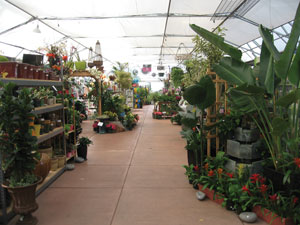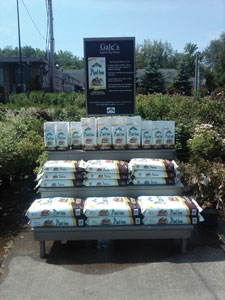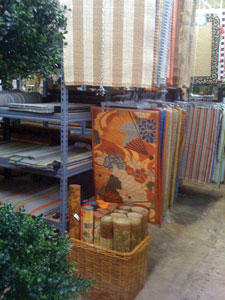8/24/2010
Merchandising: Headache Relief
Meghan Boyer
Garden centers typically carry products that are difficult to merchandise, from plants to bulky bagged fertilizers and soils. In addition to these challenges, they also must overcome the same merchandising conundrums faced by all retailers, such as needing to choose SKUs selectively and transitioning products season to season.
Overcoming these and other merchandising headaches requires realizing one retailer can’t be everything to every shopper. It’s also important to have a creative eye and consider all store spaces—including the walls, floor and even ceiling—as fair game for displaying products.
The Nexus greenhouse at Cornell Farm might not be very wide, but they make up for it by maximizing vertical space. Tall houseplants, birdbaths and larger gift items sit atop arbors, gondolas and tables, and they’ve also installed a grid wall to hold hard goods.
Nexus greenhouse at Cornell Farm might not be very wide, but they make up for it by maximizing vertical space. Tall houseplants, birdbaths and larger gift items sit atop arbors, gondolas and tables, and they’ve also installed a grid wall to hold hard goods.
“We tend to think of merchandising as making products prettier, but it’s really about putting the products in the right place so the customer can make the right choice and take the product out of the store,” says Judy Sharpton of Growing Places Marketing. “Merchandising is supposed to sell. If a display is not selling, there is something wrong with it. I don’t care how pretty it is.”
Being Choosy
While it may be difficult, retailers need to define their store and make vendor and SKU choices according to that definition, says Pam Donzelli, vice president of Gale’s Westlake Garden Center. “Years ago, we could be everything to everybody. After September 11, business changed forever, and we had to change with it,” she says.
Pam now selects vendors that perform well and are the best fit for her store—and she pushes them aggressively. “I pick a product, and I hit it big,” she says. For example, instead of carrying multitudes of organic fertilizers, Pam chose Espoma and promoted it through end caps and signage. She took that tactic with a few lines and succeeded in boosting their sales, says Pam.
“Merchandise selection is so important,” she says. “You can merchandise everything beautifully, but if it isn’t what people want, they won’t buy it.”
Having too many SKUs is a problem many garden centers face, especially in bagged goods, says Judy, noting a store may have 30 or 35 different SKUs with each one requiring a 4 ft. by 4 ft. pallet space. She encourages garden centers to evaluate the SKUs they have, determine the top sellers and trim some of the others from the inventory. “Once you evaluate those SKUs and figure out which are the best sellers, it gets easier to get those SKUs and place them somewhere convenient” that will maximize sales, she says.
Having too many SKUs ultimately reduces product impact on the shopper, says Pam, noting most consumers are overstimulated. “You don’t need 20 different watering cans. You can make an impact with two, and merchandise displays will echo that,” she says.
Where a store places its products also must make sense, notes Pam. “From the very beginning when talking initial set up, does your floor plan make sense to your customers? Do you have everything together?” she asks.
Pam tries to avoid a “hodge-podge” look by grouping like products together. “We try not to spread our products all over the store with no purpose,” she says. “All of our container products are together, all of our garden ornament is together, all of our gift is together.”
Indeed, some garden centers try spreading their hard goods throughout the store, says Judy. Shoppers like to compare products and see the choices together, but “we tend to spread stuff all over the space instead of concentrating it,” she says, noting time-starved customers don’t want to search throughout the store to see every type of birdbath available. “They would like to go to a spot and see the choices and make a buying decision,” says Judy.

Pam Donzelli of Gale’s Westlake selects vendors that perform well and are the best fit for her store. Instead of carrying multiple organic fertilizer brands, Pam chose Espoma and promoted it through end caps and signage.
A challenge in itself is finding the time to plan and execute merchandising schemes. “Displays must be pl
anned out, put together quickly, and be inspiring,” says Berkeley Blatter, merchandiser at Cornell Farm. The most-efficient process is to allow merchandisers the time they need to be creative, and major alterations should take place after hours, she says. “At the end of the day the only aspect that matters is if it sells the product,” says Berkeley.
Where to Put It?
Once a garden center has made vendor and SKU choices, the question of where and how to merchandise the products arises. For stores with limited floor and/or stock space, this can be a challenge—especially when it comes time to transition seasonal products in and out.
The biggest challenge at Nicholson-Hardie Nursery and Garden Center is where to put everything, says Mary
Ann Day, buyer for the store. “We don’t have a stock room. We barely have a very small receiving area. Other than that, everything goes on the floor,” she says. This meant in July Mary
Ann was determining where to receive, price and keep the holiday merchandise.
The seasonal transition from summer to Christmas and all the months in between is among the biggest challenges at Gale’s, says Pam. It can be difficult to transition the merchandise and the feel of the store “so it makes sense,” she says. Pam keeps the shelves full all year and the store looking fresh by keeping the most seasonally appropriate merchandise up front and transitioning the new merchandise in to the store from the back. “We moved the furniture up because it’s summer, but as we wind down fall creeps up front, and Christmas starts coming behind,” she says.
A staging area helps Mary
Ann prepare incoming merchandising. She uses an area of the store, usually in hard goods, to do receiving. After unpacking the holiday merchandise, she tries “to find some square footage in the store where I can put ornaments and those things so it doesn’t hit you in the face,” says Mary
Ann.
Part of the solution was looking up: “Height works very, very well,” says Mary
Ann. She places items in big containers that sit on high shelves and in baskets. It both looks appealing and is out of the way. “As we get close to the time we need them, I bring them back down,” she says.
Vertical displays have helped Nicholson-Hardie organize numerous products, from watering cans hung on chains to hanging baskets filled with moss balls to door mats and rugs hung on rods. The volume of doormats the garden center sold increased after Mary
Ann re-merchandised them on inexpensive warehouse fixtures and rods with chains hanging from the ceiling.
Vertical displays have helped Nicholson-Hardie organize numerous  products. Doormat sales rose after they were re-merchandised on rods and hung from the ceiling.
products. Doormat sales rose after they were re-merchandised on rods and hung from the ceiling.
Space also can be difficult for Cornell Farms, which keeps all of its houseplants, hard goods and gifts in a 100 ft by 30 ft. by 15 ft. greenhouse. “While our Nexus might not be as wide as some, we make up for the lack of width by maximizing vertical space,” says Berkeley. “Tall houseplants, birdbaths and larger gift items sit atop arbors, gondolas and tables.” Additionally, the garden center installed a grid wall to the side of the greenhouse to hold any hard goods merchandise that can hang, she says.
What About Plants?
Though they are garden centers’ main products, plants can be among the most challenging products to merchandise. “I find plants a challenge,” says Pam. “That’s because it’s so fast, and it’s changing, and there’s a lot of damage that can go with them from people shuffling through,” she says.
When merchandising plants, it’s important first to group sun and shade products separately. “You have got to be sure that you can direct your customer to sun and shade easily,” says Judy. “You can’t mix those two up” because shoppers may get confused, she says.
Second, garden centers also should group plants “not by variety but by color,” says Judy, noting this works best for living things and not gifts, hardgoods and such. Merchandising by color is a double opportunity for garden centers when it comes to plants. “If you can double-inventory those plants into color areas, then the customer can find that product and the staff can say, ‘What color were you looking for?’” she says. Most shoppers can tell a sales associate what colors they want before they can describe specific varieties.
Berkeley lists houseplants among the easiest categories to merchandise, because they can be “broken down into high and low light categories, displayed by wet and dry water needs, by complementing colors or shapes and by pot size,” she says. At Cornell Farm, such plants are merchandised along walkways, at door entrances, with indoor pottery or in miniature gardens with arbors and water features, she says.
Ultimately, to solve merchandising headaches, garden centers have to find new ways to use their spaces, says Mary
Ann. “The first thing you have to do is identify the space you are not using. Figure out what that space is and then work out how you could use it,” she says.
Many merchandising lessons come from trial and error, notes Pam. Seeking education from fellow garden centers or industry associations and trade shows can help, as can brainstorming ideas with fellow workers in the store.
“Above all, the display must sell the product,” says Berkeley. “It must be interesting and inspiring to the customer.”
GP